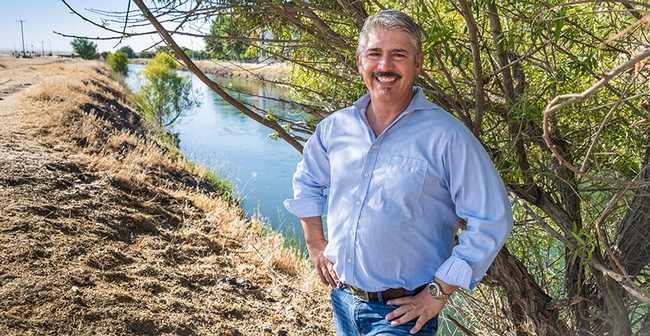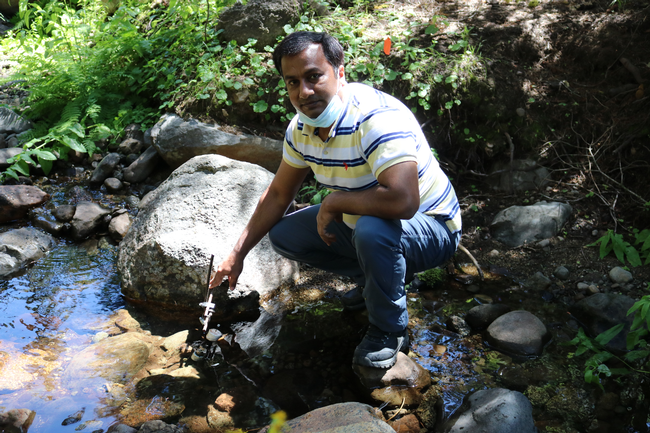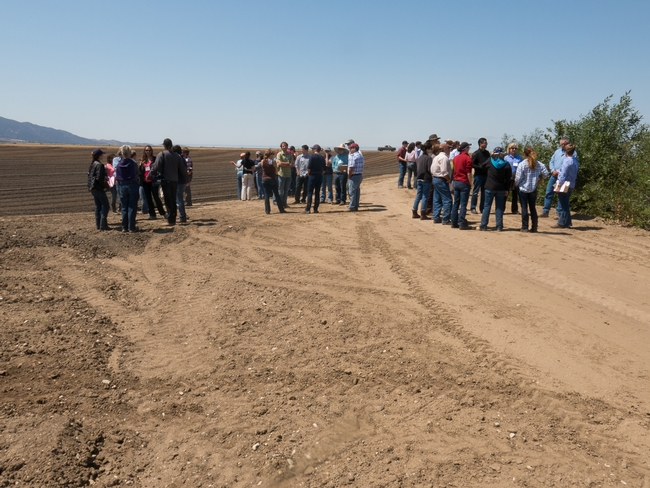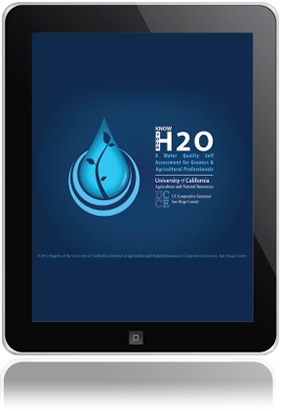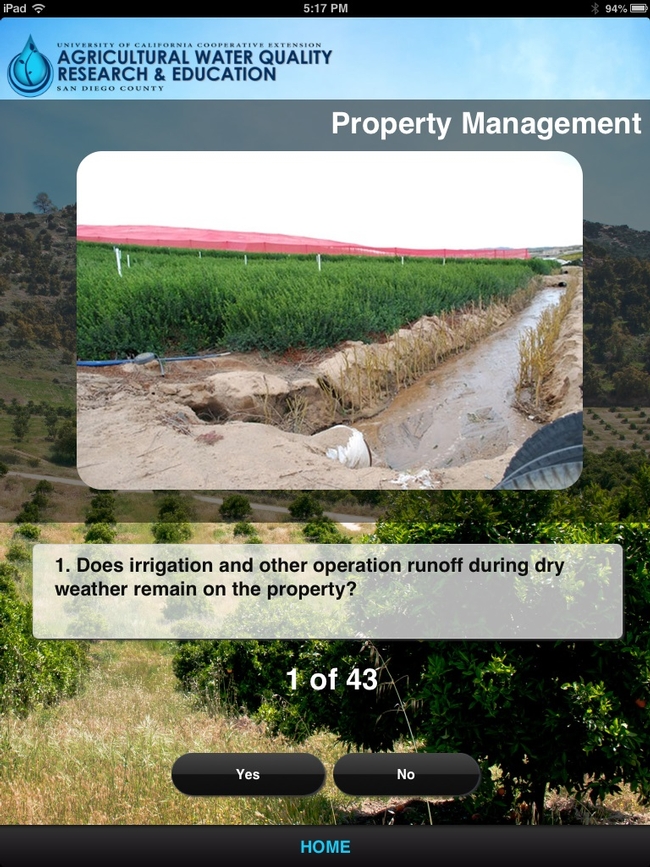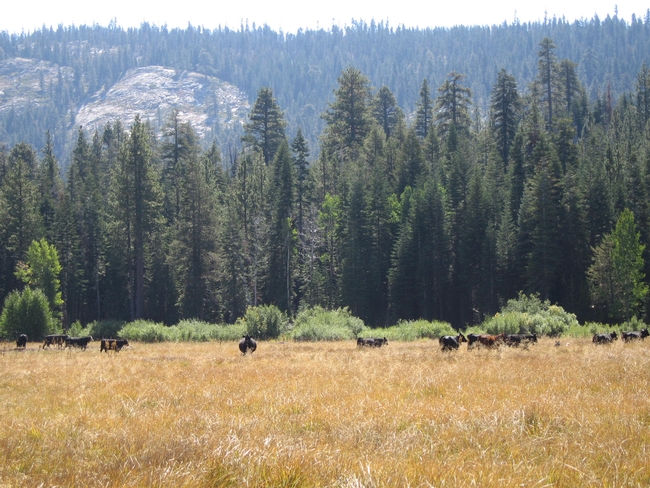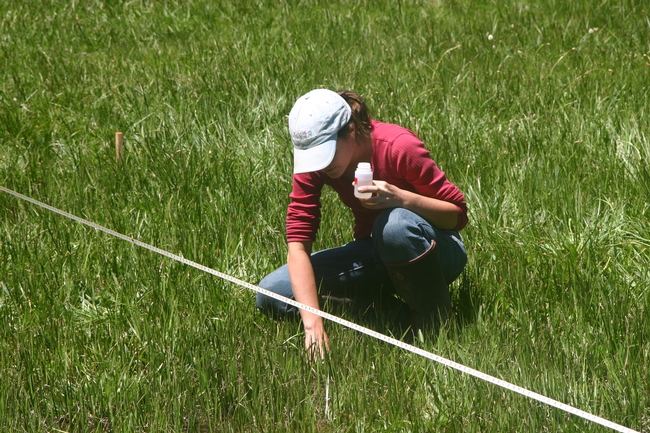Posts Tagged: Water Quality
UC Merced leads innovative effort to secure water for agriculture and ecosystems
UC Merced's largest research grant in its 16-year history aims to improve agricultural and environmental water resilience. The new $10 million collaborative focuses on water banking, trading and improvements in data-driven management practices to arrive at a climate-resilient future in water-scarce regions of the United States.
The U.S. Department of Agriculture announced it is funding the wide-ranging effort from multiple institutions across three states through its National Institute of Food and Agriculture's Agriculture and Food Research Initiative on Sustainable Agricultural Systems. The coalition of researchers is led by UC Merced, joined by experts from UC Berkeley, UC Davis, UC Agriculture and Natural Resources, Utah State University, the New Mexico Water Resources Research Institute at New Mexico State University, the Public Policy Institute of California, Environmental Defense Fund, and the U.S. Geological Survey's Southwestern Climate Hub.
“There are a lot of challenges in balancing the needs of agriculture and ecosystems, and climate change and drought are only exacerbating difficult decisions about how to sustain water resources,” lead project director UC Merced Professor Joshua Viers said. “But our team of advisors, educators and scientists are eager to enable data-driven decision-making for securing a climate resilient future for our water-stressed regions.”
The partners in the USDA funded collaboration — Securing a Climate Resilient Water Future for Agriculture and Ecosystems through Innovations in Measurement, Management and Markets or SWIM — will focus on developing more robust, data-driven information systems for decision-makers such as land and water managers. SWIM is designed to provide objective measures of supply and demand, and incorporate drought forecasting and climate change trends.
The research and extension team, by working with local decision-makers, will improve the accuracy of measurement in water budgets, evaluate novel management strategies such as on-farm aquifer recharge, and evaluate water trading and markets to improve sustainable surface and groundwater use.
The SWIM project will work across disciplines and stakeholders, integrating research, extension and education in three testbeds with unique water policies and systems: Cache Valley, Utah; Mesilla Valley, New Mexico; and the San Joaquin Valley. All of them grow orchard crops and alfalfa, and all are in a drought. Like California, Utah is experiencing an unprecedented drought, where 99 percent of the state is in extreme or exceptional drought. And, like California, the physical and cultural geography of New Mexico is extremely diverse. Exploring all innovative avenues of water management is necessary for sustaining a future for agriculture and surrounding communities while balancing ecosystem needs across the west, Viers said.
SWIM's leadership plans such activities as workshops and field days to actively engage stakeholders, including the extension-grower networks of each state's university system, as well as land, water and ecosystem managers.
Researchers from UC Merced include Viers, professors John Abatzoglou, Tom Harmon, Teamrat Ghezzehei, Josué Medellín-Azuara and Colleen Naughton, UC ANR Extension Specialist Safeeq Khan, Chelsea Arnold, who oversees the CalTeach program through the School of Natural Sciences, and researchers Leigh Bernacchi, Max Eriksson and Nicholas Santos.
“The SWIM project aims at bringing the sustainability science from ‘silos' to impact by systematically engaging our stakeholders and clientele in the knowledge co-production and systems thinking,” said Khan, UC Cooperative Extension specialist in water and watershed sciences.
“The project will build on the existing work of UC ANR networks and academics in understanding the needs of growers, irrigation districts, and ecosystem managers and co-developing data and tools to help adopt and adapt climate-resilience strategies. Our emphasis is not only on producing science and decision-support tools, but also using the project as an opportunity for social learning, knowledge empowerment, science communication, and workforce development through extension and outreach.”
In addition to ongoing activity at UC ANR's Kearney Research and Extension Center, one of the testbeds in California will be the new UC Merced Experimental Smart Farm. Researchers will collect soil, water and crop data, track droughts, conduct water accounting and life-cycle assessments, and produce user-focused data and analysis there and in the other two regions.
“The western United States is experiencing declining surface water and groundwater, adding stress on all aspects of the social-hydrological system,” said co-investigator Sam Fernald, director of the New Mexico Water Resources Research Institute at New Mexico State University. “The lessons learned in this project will offer a blueprint for addressing future water challenges, not just in the West, but other locations worldwide facing similar water shortage issues.”
The researchers want to answer many pressing questions, such as how much the changing characteristics of multi-year droughts alter people's willingness to engage in water trading and banking as part of climate resilience efforts; whether drought early warning systems propel water trading; how ecosystem services can be maintained while adapting agricultural water management to anticipated extremes; what are the key drivers and barriers adopting or participating in water markets; and how new data and technology can reduce costs and barriers.
They will also look at how climate change impacts can be mitigated through a rainy-day storage option called managed aquifer recharge or MAR, as well as water trading at multiple scales and land-use planning so that agriculture and the environment can be sustained.
One key component of creating a sustainable future is through educational programming, one of the core activities of the grant. The Climate Adaptation Science Academy will give affiliated graduate students the jump on their careers as leaders in science and engineering by providing training in climate adaptation science, communications and complex systems problem solving.
“Expanding the reach of our program are transformational K-12 educational tools,” Viers said. “Educators and graduate students will develop curricular materials for AgSTEM education pathways reaching from rural, regional middle schools to the teachers serving underrepresented groups.”
The SWIM team plans to develop such tools as games that support computational thinking and decision-making, activities in which students learn about agriculture and careers in smart farming, and hands-on experiential learning.
As associate dean for research in the School of Engineering and the director of the campus's branch of the Center of Information Technology and Research in the Interest of Society (CITRIS and the Banatao Institute), Viers discussed the role of UC Merced in providing tangible solutions to pressing societal problems:
“It has been clear for some time that water scarcity is our new reality, and we know we need to do things differently,” he said. “This research award is the largest that USDA makes to universities, and it is clear that they believe UC Merced and our affiliates are the right team with the right ideas to help secure a climate resilient water future.”
Originally published at https://news.ucmerced.edu/news/2021/uc-merced-leads-innovative-effort-secure-water-agriculture-and-ecosystems.
Balancing food safety and water quality not cheap or easy, but it can be done
To help farmers and growers efficiently achieve the best results, the University of California Cooperative Extension, in collaboration with the Farm Food Safety and Conservation Network brought together 80 people on Aug. 20 for the seventh annual Food Safety and Water Quality Co-management Forum.
Participants represented food safety and conservation professionals, food safety auditors, academics, and government agency personnel. This cross-section of the fresh produce community provided diverse perspectives beneficial to discussions on balancing food safety and water quality objectives in agricultural production. As State Water Resources Control Board member Steve Moore noted, "Decisions based on collaborative efforts have the most durable solutions."
Forum participants heard the latest information on drought effects to water resources and innovative strategies to provide water to agricultural operations, including existing recycled water projects. Panelists presented the latest information on existing and pending regulations that affect co-management, and fresh produce growers discussed practical strategies to manage agricultural production for food safety and sustainability outcomes.
“Research is continuing to support the decisions of fresh produce growers in balancing food safety and water quality on their farms” explained Mary Bianchi, UC Cooperative Extension advisor in San Luis Obispo and Santa Barbara counties. “The question now is how do we put that knowledge into action in the face of the current California drought and pending state and federal regulations of both water resources and food safety? Discussion among stakeholders, whether that be produce growers and buyers or conservation professionals and policymakers are a key component of the process of co-management.”
The forum concentrated on the types of practices and policy programs that may help, and discussed strategies, both field-based and policy-driven, that might support progress in addressing persistent resource concerns relevant to agricultural production.
“This forum always provides a great networking opportunity for any decisionmakers influencing policy or implementing environmental protection or on-farm food safety strategies,” said Kaley Grimland-Mendoza, small farmer enterprise development specialist for the Agriculture and Land-Based Training Association.
The first panel of the day focused on the opportunities and challenges of co-managing water resources and food safety in California's current drought. The panel was moderated by Johnny Gonzales, water resource control engineer and Irrigated Lands Regulatory Program coordinator with the State Water Resources Control Board, and included Robert Johnson, assistant general manager and chief of water resources planning for the Monterey County Water Resources Agency; Robert Holden, principal engineer of the Monterey County Water Pollution Control Agency's Castroville Seawater Intrusion Project; Jeff Cattaneo, San Benito County Water District manager; Samir Assar, director of Produce Safety for the US Food and Drug Administration; and Moore.
A panel of local growers representing diverse commodities and operational sizes discussed their daily process of co-managing for food safety and water quality. The panel included Michael Brautovich, senior manager for Farm Quality, Food Safety and Organic Integrity at Earthbound Farm/Natural Selection Foods; Brendan Miele, director of Domestic Farm Relations for Jacobs Farms / Del Cabo Inc; Chris Drew, Sea Mist Farms production manager; and Rebecca Bozarth of Harvest Moon Agricultural Services.
Following the panel discussions, participants visited an organic vegetable farm near Salinas. The landowner, growers, conservation, and food safety professionals discussed food safety and water quality opportunities, challenges and possible alternatives with an emphasis on solutions that exemplify co-management. The discussion also included questions that arise in a decision-making process and where more information or research is needed.
FDA's Samir Assar participated both as a panel member to answer questions about the proposed Produce Safety Rule and in small group discussions during the field exercise to explore co-management challenges and strategies at one local produce farm.
“The farm visits are essential for farmers to observe what food safety practices others are implementing to reduce risks and tailoring such practices to their farm operations while maintaining on-farm conservation value,” Grimland-Mendoza said. “It would be great to have representation and participation from large produce buyers, who have historically been the most skeptical of co-management strategies and have required the most stringent food safety practice requirements.”
Participants were surveyed before and after the forum. “After the forum, 96 percent of the participants felt they understood co-management principles, 31 percent higher than at the start of the day,' Bianchi said, “and 85 percent of the participants felt that they could incorporate what they learned into the decisions they make.”
For more information about co-management, visit http://cesanluisobispo.ucanr.edu/Co-management_of_Food_Safety_and_Sustainability or contact Mary Bianchi, UC Cooperation Extension farm advisor in San Luis Obispo and Santa Barbara counties, at (805) 781-5949 or mlbianchi@ucanr.edu.
Got Ants? Get S.E.R.I.O.U.S.
There is a new resource available to anyone that has dealt with ants. It is a website called Got Ants? Get S.E.R.I.O.U.S.! It is as they say on their website “a collaboration of public agencies, educational institutions, pest professionals, and nonprofits working to promote environmentally sound ant management and to protect water quality.” You may or may not know that the pesticides commonly used for ant control are some of the most prevalent and damaging in our waterways. People spray them on their own or hire companies to do it for them. The truth of the matter is that spraying is not the most effective or cost effective means of controlling ant invasions. The Got Ants folks have put together a very simple system for dealing with ants. Their acronym S.E.R.I.O.U.S. stands for:
S – Spot where ants are coming in.
E – Eliminate crumbs, messes and spills
R – Rinse with soap and water
I – Isolate food and water sources
O – Obstruct entryways and seal cracks
U – Use baits if ants don’t go away
S – Stick to it to keep ants away
In addition to strategies for handling ant invasions the Got Ants website asks you to make a pledge “to use less toxic practices (or hire a company certified to provide less toxic IPM services) the next time you have an ant problem.” I’ve added my name to the list. I encourage you to do the same.
By the way, if you want to read a synopsis of a study done by Stanford researchers that indicates that ant invasions, and more importantly, their retreat are due to weather, I'm including the link. As stated in the article; "People spend a lot of money on year-round pesticides," says Deborah M. Gordon, associate professor of biological sciences and lead author of the study, "but it's not the pesticide that keeps ants out of your home, it's the weather."
http://news.stanford.edu/pr/01/ants45.html
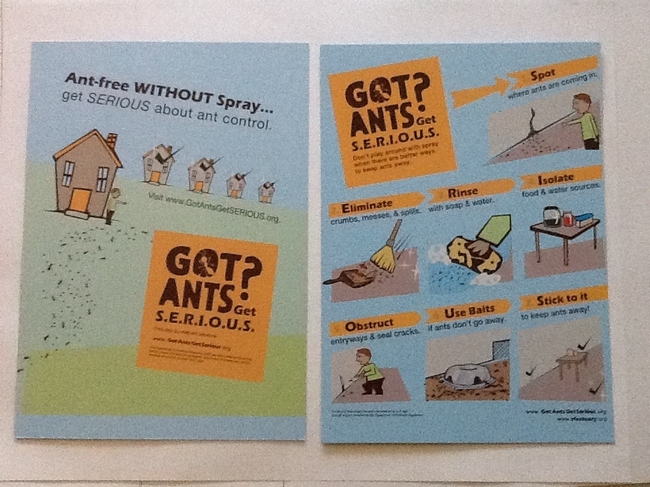
photo(39)
Mobile app helps growers protect water quality
Although there are many sources of water pollution, runoff from farms may contain contaminant levels that exceed water quality standards. Runoff from agricultural operations can pick up and carry natural and man-made pollutants, including fertilizers, salts, pesticides and sediments to lakes, rivers, wetlands and beaches, according to Loretta M. Bates, UC Cooperative Extension staff research associate, who leads the Agricultural Water Quality Research and Education Program in San Diego County.
Avocados and citrus are major tree crops in San Diego County, but “the app should be useful for growers of any tree crops,” says Bates.
The self-assessment questions fall into the following categories:
A. Property Management
B. Road Management & Erosion Control
C. Irrigation Practices
D. Leaching & Runoff
E. Nutrient Assessment & Fertilizer Management
F. Integrated Pest Management
“In the near future, we will have apps available for nursery and greenhouse growers and the apps will be available for use with devices other than iPads,” Bates says.
The tree crops app was developed by Ryan Krason, digital media specialist for UC Cooperative Extension in San Diego County, and Valerie Mellano, former UC Cooperative Extension advisor in San Diego County, with a third-party app developer. Krason and Bates are currently working on customizing the app for nursery and greenhouse operations.
The iPad app for tree crops is free and can be downloaded from the iTunes store. Search for "agricultural water quality."
For tree crop growers who don’t have iPads, the self-assessments can be printed off the Web at http://ucanr.org/sites/agwaterquality/files/121819.pdf and completed by hand. The Agricultural Water Quality Research and Education Program also offers printable self-assessments for greenhouse and nursery businesses and animal agriculture operations on the Web. While the iPad app will generate a report of suggestions, the print versions offer statements that address a group of questions.
For more information about the UC Cooperative Extension Agricultural Water Quality Research and Education Program, its iPad water-quality self-assessment app or other online assessment tools, visit http://ucanr.edu/sites/agwaterquality/Grower_Resources.
Cattle grazing and clean water not mutually exclusive
Cattle grazing and clean water can coexist on national forest lands, according to research by the University of California, Davis.
The study, published June 27 in the journal PLOS ONE, is the most comprehensive examination of water quality on National Forest public grazing lands to date.
“There’s been a lot of concern about public lands and water quality, especially with cattle grazing,” said lead author Leslie Roche, a postdoctoral scholar in the UC Davis Department of Plant Sciences. “We’re able to show that livestock grazing, public recreation and the provisioning of clean water can be compatible goals.”
Roughly 1.8 million livestock graze on national forest lands in the western United States each year, the study said. In California, 500 active grazing allotments support 97,000 livestock across 8 million acres on 17 national forests.
“With an annual recreating population of over 26 million, California’s national forests are at the crossroad of a growing debate about the compatibility of livestock grazing with other activities dependent upon clean, safe water,” the study’s authors write.
“We often hear that livestock production isn’t compatible with environmental goals,” said principal investigator Kenneth Tate, UC Cooperative Extension specialist in the Department of Plant Sciences at UC Davis. “This helps to show that’s not absolutely true. There is no real evidence that we’re creating hot spots of human health risk with livestock grazing in these areas.”
The study was conducted in 2011, during the grazing and recreation season of June through November. Nearly 40 UC Davis researchers, ranchers, U.S. Department of Agriculture Forest Service staff and environmental stakeholders went out by foot and on horseback, hiking across meadows, along campsites, and down ravines to collect 743 water samples from 155 sites across five national forests in northern California.
These areas stretched from Klamath National Forest to Plumas, Tahoe, Stanislaus and Shasta-Trinity national forests. They included key cattle grazing areas, recreational lands and places where neither cattle nor humans tend to wander.
UC Davis researchers analyzed the water samples for microbial and nutrient pollution, including fecal indicator bacteria, fecal coliform, E. coli, nitrogen and phosphorous.
The scientists found that recreation sites were the cleanest, with the lowest levels of fecal indicator bacteria. They found no significant differences in fecal indicator bacteria between grazing lands and areas without recreation or grazing. Overall, 83 percent of all sample sites and 95 percent of all water samples collected were below U.S. Environmental Protection Agency benchmarks for human health.
The study noted that several regional regulatory programs use different water quality standards for fecal bacteria. For instance, most of the study’s sample sites would exceed levels set by a more restrictive standard based on fecal coliform concentrations. However, the U.S. EPA states that E. coli are better indicators of fecal contamination and provide the most accurate assessment of water quality conditions and human health risks.
The study also found that all nutrient concentrations were at or below background levels, and no samples exceeded concentrations of ecological or human health concern.
The study was funded by the USDA Forest Service, Region 5.
The study has been covered by Bloomberg, Cattle Network, Progressive Cattle, Science Daily and AgWeb.


